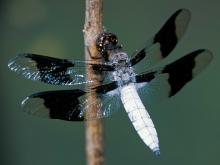Land Invertebrates
Media

Species Types
Scientific Name
More than 900 species in North America north of Mexico
Description
Millipedes, which have two pairs of legs per body segment, are harmless detritus-eaters, move slowly, and curl up defensively when harassed.
Media

Species Types
Scientific Name
Lepisma saccharina, Thermobia domestica, and other species
Description
Silverfish are known worldwide, since they commonly live in our homes. There are a number of species in this family of insects, including the common silverfish and the firebrat.
Media

Species Types
Scientific Name
Loxosceles reclusa
Description
The brown recluse is a spider whose venomous bite may be medically significant to humans, though a bite is almost never fatal. Brown recluses are most commonly encountered in houses, where they occupy little-used drawers, closets, and other small hiding spaces.
Media

Species Types
Scientific Name
Nearly 250 species in North America north of Mexico
Description
A wolf spider doesn't spin webs to catch its prey — it runs it down like a wolf! Spiders in this family have long legs and are usually gray, brown, black, or tan with dark brown or black body markings (especially stripes).
Media

Species Types
Scientific Name
Pisaurina spp.
Description
Nursery web spiders build silken tents in plants to protect their egg sacs, then stand guard until the hatchlings are ready to disperse. Large and velvety, nursery web spiders have long legs and variable color patterns.
Media

Species Types
Scientific Name
Pholcus, Psilochorus, and others in the Pholcid family
Description
Cellar spiders look wispy with their incredibly long, thin legs and habit of bouncing rapidly in their cobwebs when disturbed, which turns them into a blur. Some species are very common in homes.
Media

Species Types
Scientific Name
About 6,500 species have been named so far, worldwide.
Description
Daddy longlegs, or harvestmen, are familiar Missouri animals. They are not spiders, but opilionids. Unlike spiders, they have a fused body form and lack silk and venom glands.
Media

Species Types
Scientific Name
Tetragnatha spp.
Description
Longjawed orbweavers are called stretch spiders because they rest with their legs stretched straight out in front of and behind their slender bodies. They build their circular webs horizontally, within a few feet above the surface of a stream or lake.
Media

Species Types
Scientific Name
Phanogomphus graslinellus
Description
The pronghorn clubtail is one of several members of its genus in our area that are generally difficult to identify. Like other dragonflies, it is an aerial predator that hunts insects on the wing.
Media

Species Types
Scientific Name
Plathemis lydia
Description
The common whitetail is a widespread species found across much of North America. Males and females look quite a bit different.
See Also



Media

Species Types
Scientific Name
Cisseps fulvicollis
Description
The yellow-collared scape moth is more often “orange-collared.” And whether you think it looks more like a firefly or a wasp, it’s still a moth!
Media

Species Types
Scientific Name
Nearly 150 species in North America north of Mexico
Description
Slim, delicate plume moths are instantly recognizable by their T-shaped silhouette, long legs, and muted shades of tan and brown. It can be hard to separate the various species.
Media

Species Types
Scientific Name
Pyrrharctia isabella
Description
Not many people know the adult Isabella tiger moth when they see one, but we’re all acquainted with its caterpillar, the woolly worm, or woolly bear.
About Land Invertebrates in Missouri
Invertebrates are animals without backbones, including earthworms, slugs, snails, and arthropods. Arthropods—invertebrates with “jointed legs” — are a group of invertebrates that includes crayfish, shrimp, millipedes, centipedes, mites, spiders, and insects. There may be as many as 10 million species of insects alive on earth today, and they probably constitute more than 90 percent all animal species.





















